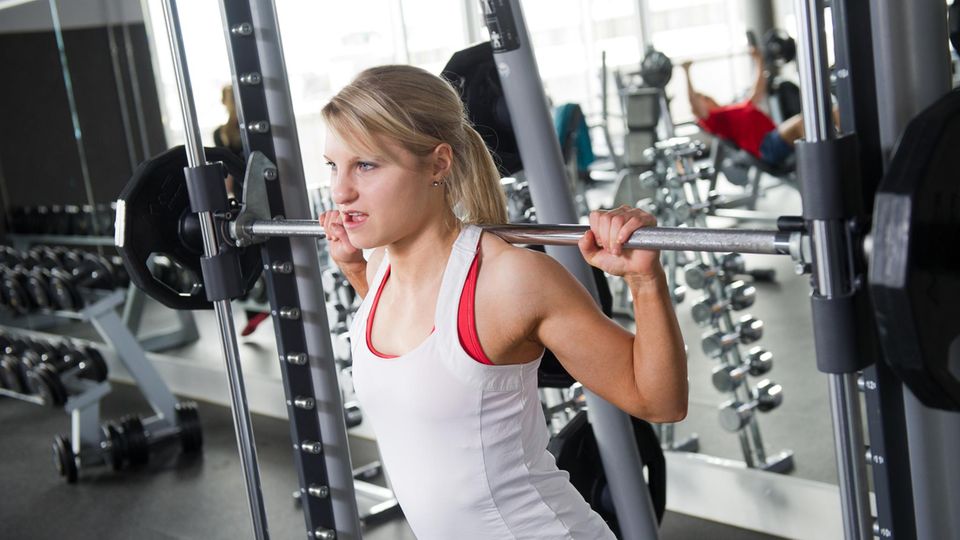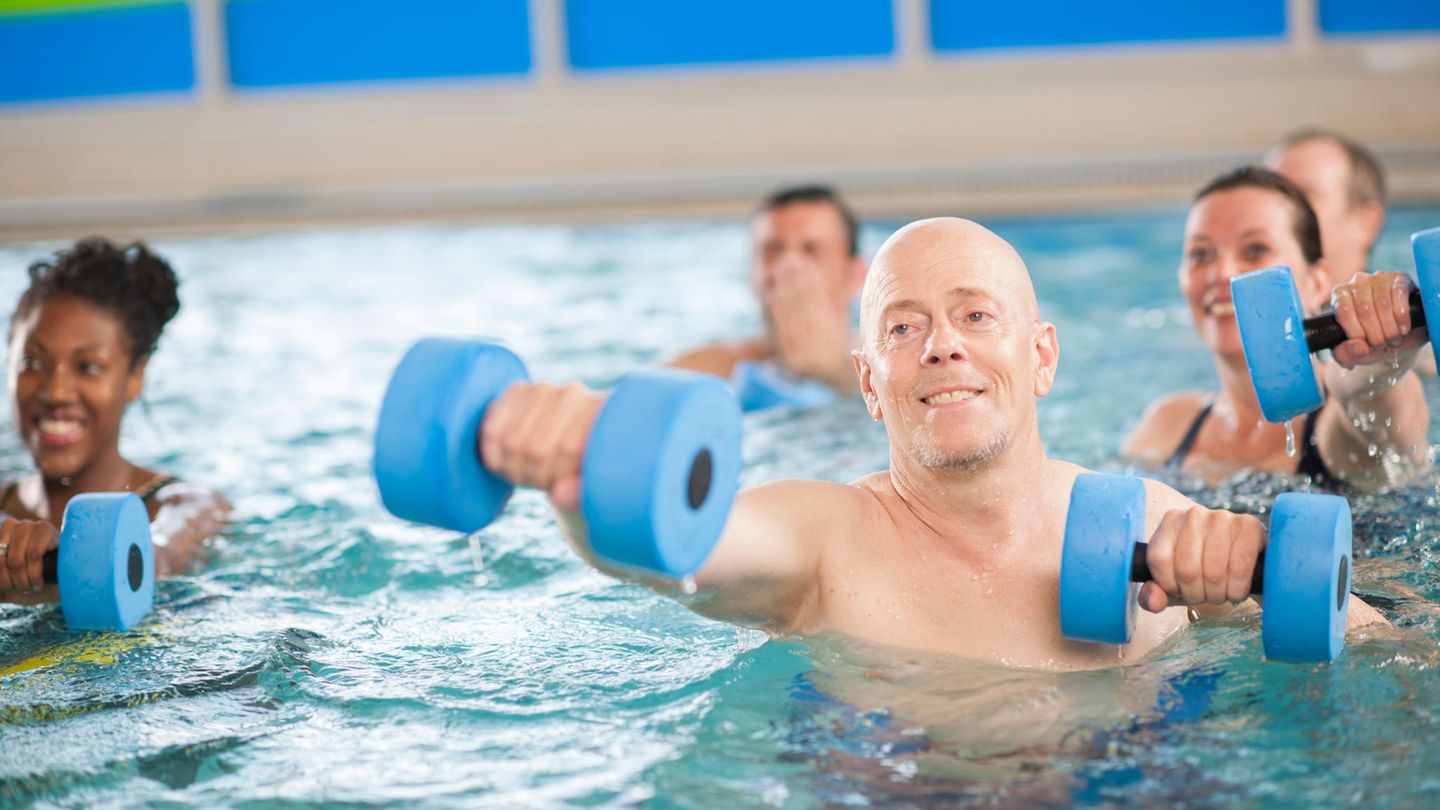Once frowned upon as aqua aerobics for seniors, aquafitness has established itself as a whole body workout for everyone. Read here why aqua jogging, aquaboxing and the like are the perfect alternative to the fitness studio.
Aqua jogging was frowned upon for a long time. Among swimmers as well as among runners. As senseless jumping around in the waist-deep and lukewarm paddling pool. Nothing half and nothing whole. Treading water for seniors with too much time. These and other clichés hovered everywhere over the fitness method, which at first glance looks a bit strange. Admittedly: the lifestyle factor in aqua jogging is manageable. Nevertheless, aqua aerobics has not only established itself in rehabilitation, it is recognized as a full-body training that is not only extremely gentle on the joints, but also particularly efficient – for amateur, amateur and competitive athletes alike.
Read why aqua jogging is more than jumping around in the shallow children’s pool and why top athletes and many team athletes also rely on it.
Water beats dumbbells and running shoes
Swimming is one of the most demanding endurance sports there is. Anyone who does not really master the technology – regardless of the style – will never be really happy with the element of water. The problem (or also the advantage): water has a density 800 times higher than air. The body has to use significantly more energy in the swimming pool to move forward than when jogging in the park. Anyone who has ever tried to walk in water – even if only in knee-deep water – will have noticed that the strength quickly disappears. To mark aqua fitness in general and aqua jogging, aquazumba, aquaboxing and much more as a pastime for seniors is complete nonsense. Quite the opposite: Instead of dragging tired and stressed bones over the asphalt or maneuvering dumbbells from A to B in the gym uncontrollably, water is predestined as a fitness device – for young and old, fat and thin, those who don’t like sports and top athletes.
Aqua jogging – who invented it?
Someone specific John Glenn McWaters – no, that’s not an artist name – developed the training method, which is now recognized worldwide, in the 1970s – and called it “Deep Water Running”. More precisely, the resourceful US Navy officer experimented with training aids that make running in deep water possible. The result was the so-called “Wet Vest”, a neoprene vest. Athletics trainer McWaters recognized the benefits of aqua jogging early on and tried to use it to get his soldiers into a solid state of fitness. The tools have been further developed. Nowadays, when doing aqua jogging, you strap a so-called buoyancy belt made of foam around your upper body or slip on a foam vest. Both tools are light and comfortable and, in addition to being buoyant, support balance in the water.
In Germany, the movement therapist applies Margot Zeitvogel-Schönthier as a pioneer of aquatraining. She has been looking after and advising winter sports enthusiasts in particular for many years – including athletes from the German, Swedish and Canadian Ski Associations. The author of numerous specialist books has also established various methods of training in water in tennis, handball, football and climbing – including aqua jogging.
Why aqua jogging instead of a run in the park?
First of all, water has a resistance several hundred times greater than air. That makes the training a bit more strenuous in the long run, but that’s what Trainingseffekt a lot bigger. Because of the increased hydrostatic pressure more blood is pumped to the heart – that Stroke volume increases by up to 20 percent. Conversely, the heart rate drops. It is assumed that the Maximum heart rate approx. Eight to ten beats lower is like running on land. In aqua jogging, you can achieve the same training effect when running in the park with significantly less stress.
In addition, you train because of the Buoyancy effect only with one Fraction of your own body weight (In chest-deep water, 70 kg body weight on land becomes seven kg). Which – and this is one of the great advantages of aqua jogging – has a positive effect on the joints, muscles and tendons. With conventional running – whether on park paths, asphalt roads or anywhere else – they are exposed to considerable stress due to the permanent compression. “The risk of injury is almost zero,” says Ingo Froböse, professor at the German Sport University in Cologne.

Zeitvogel-Schönthier also swears by the massage effect of water. “It caresses and kneads the skin like a thousand tender hands”. This is ensured by the aforementioned hydrostatic pressure and the natural frictional resistance of water. The more intensely the movements are performed, the stronger the effect. And that is also reflected in the body weight. Froböse: “Due to the slower movements in the water, the muscles mainly rely on fat reserves instead of sugar deposits.” Due to the improved blood circulation, the connective tissue is also tightened. Cellulite is also an issue when you go aqua jogging.
What types of aqua jogging are there?
There are two types of aqua jogging. at version 1which is especially recommended for seniors, the legs are in contact with the ground (Water Running). The training takes place in a pool with a water depth of less than 1.50 meters. The advantage: no tools are required. Important: With every step you push the ball of your foot off the bottom of the pool. In variant 2, you train in deep water. (Suspended Deep Water Running) A foam belt provides buoyancy. Important: The upper body is bent slightly forward and the slightly bent arms swing easily with the running movement. as Basic rule The following applies to both forms of aqua jogging: the higher the step frequency, the more strenuous, but also more effective, the training.
How many calories do you burn while aqua jogging?
Average 450 kilocalories one burns during a one-hour aqua jogging training session. According to Froböse, that’s about 150 less than cycling or running. For this, the water pressure literally helps the aqua runner’s cycle. The effect: the heart can pump more oxygen-rich blood into the arteries with every single beat. The pulse remains in the moderate range.
Aqua jogging: how often and for how long?
Two to three 45-minute sessions per week are recommended. Ideally, under the guidance and supervision of a trainer. Many public baths and gyms with swimming pools offer courses on a regular basis. You don’t have to bring anything more than swimwear. the are usually asked. If that’s not enough, you can buy the buoyancy aids yourself. Important: They should be infinitely adjustable and adapt to the body. Otherwise the belt will press too hard on the chest and interfere with breathing. In addition, the belt and arms could interfere with each other while running.
; ; ; stern Special “Healthy Living” (3/2004);
There is more information here.




